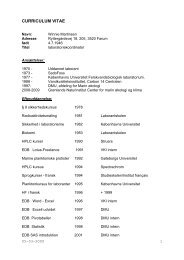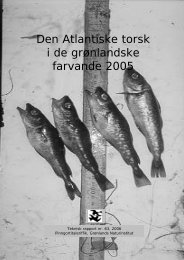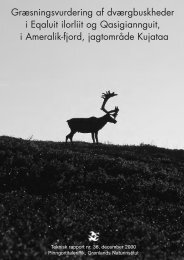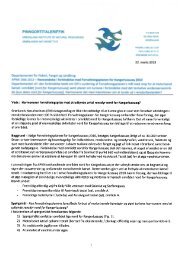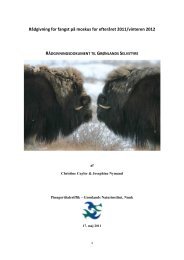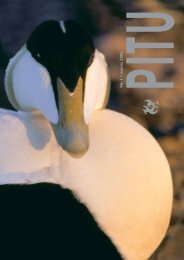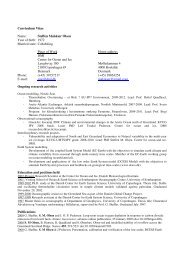Migration and breeding biology of Arctic terns in Greenland
Migration and breeding biology of Arctic terns in Greenland
Migration and breeding biology of Arctic terns in Greenland
Create successful ePaper yourself
Turn your PDF publications into a flip-book with our unique Google optimized e-Paper software.
Figure 6. An <strong>Arctic</strong> tern equipped<br />
with a geo-locator <strong>in</strong> 2007 returns<br />
to the <strong>breed<strong>in</strong>g</strong> site at S<strong>and</strong> Isl<strong>and</strong><br />
<strong>in</strong> Northeast Greenl<strong>and</strong> the<br />
follow<strong>in</strong>g year, after hav<strong>in</strong>g completed<br />
a round-trip migration <strong>of</strong><br />
more than 70,000 km.<br />
26<br />
grounds (Alerstam 1985). Cross<strong>in</strong>g over l<strong>and</strong> areas <strong>and</strong> the Greenl<strong>and</strong><br />
<strong>in</strong>l<strong>and</strong> ice at high altitude was suggested to take place <strong>in</strong> the migration<br />
<strong>of</strong> the <strong>Arctic</strong> tern <strong>in</strong> the mid-1980s us<strong>in</strong>g radar observations (Alerstam et<br />
al. 1986). There was little evidence <strong>of</strong> the northbound migration <strong>of</strong> the<br />
<strong>Arctic</strong> tern <strong>in</strong> spr<strong>in</strong>g available for Salomonsen, but a r<strong>in</strong>g<strong>in</strong>g recovery <strong>of</strong> a<br />
Greenl<strong>and</strong> r<strong>in</strong>ged bird from Columbia <strong>in</strong> the highl<strong>and</strong> <strong>of</strong> South America,<br />
led him to speculate that at least some birds may end up <strong>in</strong> the Pacifi c<br />
Ocean <strong>and</strong> cross over l<strong>and</strong> to enter the Atlantic Ocean. However, the major<br />
northbound migration was believed to be <strong>in</strong>itiated <strong>in</strong> March <strong>in</strong> the Atlantic<br />
Ocean <strong>and</strong> occur more rapidly <strong>and</strong> over a wider front compared to<br />
autumn (Kampp 2001, Bourne <strong>and</strong> Casement 1996).<br />
Several authors (e.g. Berthold 2001, Newton 2008) have attempted to estimate<br />
the total distance travelled dur<strong>in</strong>g the annual migration <strong>of</strong> the <strong>Arctic</strong><br />
tern. As the fl ight path was largely unknown, these estimates vary, but<br />
typically a fi gure <strong>of</strong> 40,000 km was quoted as the annual trip from <strong>breed<strong>in</strong>g</strong><br />
grounds to the w<strong>in</strong>ter<strong>in</strong>g grounds, <strong>and</strong> back.<br />
As advances <strong>in</strong> technology make devices for mapp<strong>in</strong>g animal migration<br />
smaller <strong>and</strong> lighter, the chance <strong>of</strong> document<strong>in</strong>g the long migration <strong>of</strong> the<br />
<strong>Arctic</strong> tern crept closer. The ideal tool for this would be a satellite transmitter<br />
with a full year <strong>of</strong> battery capacity. However, at present, satellite transmitters<br />
are still too heavy for birds with a mass under 250 gram to carry on<br />
migration. Instead, the less accurate, but much lighter geolocators (m<strong>in</strong>iature<br />
archival light loggers), have proven to be an effective tool (Richards et<br />
al. 2004). By record<strong>in</strong>g <strong>and</strong> stor<strong>in</strong>g ambient light <strong>in</strong>tensity, the geolocators<br />
reveal <strong>in</strong>formation on sunrise <strong>and</strong> sunset. When these data are comb<strong>in</strong>ed<br />
with time record<strong>in</strong>gs, two daily geographical positions can be calculated<br />
<strong>and</strong> migration routes can be mapped. The disadvantage <strong>of</strong> geolocators is<br />
that they cannot transmit data, <strong>and</strong> the tagged bird has to be caught aga<strong>in</strong><br />
at the end <strong>of</strong> the study period – a logistical challenge that normally requires<br />
that the bird nest at the same location two years <strong>in</strong> a row.<br />
Although <strong>of</strong>ten quoted <strong>in</strong> both scientifi c <strong>and</strong> popular literature as the<br />
longest migration performed by any bird <strong>in</strong> the world, a study (Shaffer et<br />
al. 2006) questioned the <strong>Arctic</strong> tern’s status as the longest migrant. Us<strong>in</strong>g<br />
geolocators, Shaffer et al. (2006) were able to document that sooty shearwaters<br />
(Puffi nus griseus) make an annual round trip from New Zeal<strong>and</strong> to<br />
the waters <strong>in</strong> the northern Pacifi c Ocean <strong>and</strong> back, <strong>of</strong> 64,037 (± 9,779) km<br />
on average.





